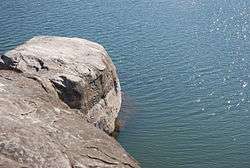Nongae
Nongae (? ~ 1593) [1][2][3] was a gisaeng of Jinju in the late 16th century, born in Jangsu, Jeolla province.[4] She has been taught and celebrated as one of the examples of personal contributions made by Korean women.[5]
| Nongae | |
| Hangul | 논개 |
|---|---|
| Hanja | 論介 |
| Revised Romanization | Non-gae |
| McCune–Reischauer | Non'gae |
Life
Born to Ju Dal-moon, who seems to have been a learned scholar, and Mrs. Park,[6] Nongae was a late-born child to the couple, whose son died young at age fifteen. When she was just 4, her father died, and her extended family plotted to take her, wanting to make her the wife of a male heir. Her mother soon found out and stole her away but was caught and jailed. Her trial was overseen by province official Choi Kyong Hwe, who ruled on behalf of her innocence, but Nongae, seeing that she had no place to go and no family to trust, at the age of 17 became his concubine and lived in his house.[4][5]
In 1592, Japanese forces invaded the Korean peninsula in the Imjin war, during which Official Choi, Nongae's husband, was assassinated. Afterwards, the Japanese eventually succeeded in their invasion of Suyeong Fortress (now near Jinju area). To celebrate the victory, soldiers forced all the kisaeng, female entertainers, to serve them at the Chokseongnu Pavilion on a cliff that overlooked the Nam River.[7] Nongae was called to entertain the victorious Japanese generals alongside the other kisaeng. She led the general Keyamura Rokusuke (毛谷村六助) to the cliffside, where she embraced him, clasped her fingers with rings that locked her around him, and cast herself along with the general into the river, killing them both.[8] It is said that she sacrificed herself not only in revenge for her husband's murder but also out of love for her country.[9] However this story is highly dubious and it is most likely to have originated from Bak Jonghwa (朴鍾和)'s Nongae and Gyewolhyang (1962).[10] The rock from which she leapt has come to be known as Uiam (의암, 義巖), "the Rock of Righteousness."[11]
Memorial

Memorials for Nongae seem to have started in the late 19th century, evidence for which is found in the record Gyobang Gayo written by a local official, Jeong Hyun Seok. It is said the festival called Uiam Byeolje took place every June to pay respects to her spirit.[12] Currently, there is a shrine to the memory of Nongae near Chokseongnu, in central Jinju.[13] Around the fortress, the Nongae festival has been celebrated since 2002 every May to honor and preserve the memory of her patriotic spirit.[11]
The portrait of Nongae painted by Kim Eun-ho had been kept in Jinju fortress, whereas his drawing was forcibly removed by a local civil group that argued Painter Kim was one of the renowned pro-Japanese artists during the Colonial Period.[14] Following on the regional government's support, a newly executed painting was adopted in 2008.[15]
See also
- Japanese invasions of Korea (1592–98)
- Military history of Korea
- Kisaeng
References
- Birth year of her is doubtful: some references indicate it would be around 1574.
- Kim, Jinwoo (2014). 한국인 성씨의 역사. 춘추필법. pp. 1622 .
- Korean culture content
- Nongae Shrine
- Elaine H., Kim; Chungmoo Choi (1998). Dangerous Women: Gender and Korean Nationalism. Psychology Press, 1998. p. 172. ISBN 0415915066.
- Hyejae, Jang; Lee, Seonyoung (2014). 기녀의 순정 논개("Nongae, the heart of kisaeng"). ebookshub. pp. 115 . ISBN 9791155191378.
- Yongyi, Pae (2008). Women in Korean History (한국 역사 속의 여성들). Ewha Womans University Press, 2009. pp. 115 . ISBN 897300784X.
- Hongsuk, Oh (2005). Traditional Korean Villages 25권/The spirit of Korean cultural roots Traditional Korean Villages. Ewha Womans University Press, 2009. pp. 123 . ISBN 897300784X.
- Mount Jirisan area reveals rich heritage and culture Korea Herald, 2014-05-23
- Choi, Gwan 崔官 (1994). Bunroku Keichō no eki [Jinshin-Teiyū Waran] 文禄・慶長の役 [壬辰・丁酉倭乱] (in Japanese).
- Jinju Nongae festival
- 진주 논개제와 함께하는 진주 봄 축제(Jinju Nongae festival together with Spring festival) Newsis, 2013-05-18
- The old name of Jinju fortress is Chokseok, and Chokseongnu is a pavilion located inside the fortress.
- "친일파가 그렸다" 논개영정 뜯어내 Chosun Ilbo, 2018-04-11
- '논개 표준영정' 만들어졌다 Gyeongsang Provincial newspaper, 2018-04-11